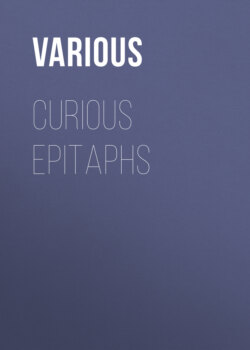Читать книгу Curious Epitaphs - Various - Страница 5
На сайте Литреса книга снята с продажи.
Typographical Epitaphs.
ОглавлениеTable of Contents
The trade of printer is rich in technical terms available for the writer of epitaphs, as will be seen from the following examples.
Our first inscription is from St. Margaret’s Church, Westminster, placed in remembrance of England’s benefactor, the first English printer:—
To the memory of
William Caxton,
who first introduced into Great Britain
the Art of Printing;
And who, A.D. 1477 or earlier, exercised that art in the
Abbey of Westminster.
This Tablet,
In remembrance of one to whom the literature of this
country is so largely indebted, was raised,
anno Domini MDCCCXX.,
by the Roxburghe Club,
Earl Spencer, K.G., President.
In St. Giles’ Cathedral Church, Edinburgh, is the Chepman aisle, founded by the man who introduced printing into North Britain. Dr. William Chambers, by whose munificence this stately church was restored, had placed in the aisle, bearing Chepman’s name, a brass tablet having the following inscription:—
To the Memory of
Walter Chepman,
designated the Scottish Caxton,
who under the auspices of James IV.
and his Queen, Margaret, introduced
the art of printing into Scotland
1507 founded this aisle in honour of the King, Queen, and their family, 1513. Died 1532. This tablet is gratefully inscribed by William Chambers, ll.d.
The next is in memory of one Edward Jones, ob. 1705, æt. 53. He was the “Gazette” Printer of the Savoy, and the following epitaph was appended to an elegy, entitled, “The Mercury Hawkers in Mourning,” and published on the occasion of his death:—
| Here lies a Printer, famous in his time, Whose life by lingering sickness did decline. He lived in credit, and in peace he died, And often had the chance of Fortune tried. Whose smiles by various methods did promote Him to the favour of the Senate’s vote; And so became, by National consent, The only Printer of the Parliament. Thus, by degrees, so prosp’rous was his fate, He left his heirs a very good estate. |
It has been truthfully said that the life of Benjamin Franklin is stranger than fiction. He was a self-made man, gaining distinction as a printer, journalist, author, electrician, natural philosopher, statesman, and diplomatist. The “Autobiography and Letters of Benjamin Franklin” has been extensively circulated, and must ever remain a popular book; young men and women cannot fail to peruse its pages without pleasure and profit.
In collections of epitaphs and books devoted to literary curiosities, a quaint epitaph said to have been written by Franklin frequently finds a place. He was not, however, the original composer of the epitaph, but imitated it for himself. Jacob Tonson, a famous bookseller, died in 1735, and a Latin epitaph was written on him by an Eton scholar. It is printed in the Gentleman’s Magazine, February, 1736, with a diffuse paraphrase in English verse. The following is at all events a conciser version:—
The volume
of
his life being finished
here is the end of
Jacob Tonson.
Weep authors and break your pens;
Your Tonson effaced from the book,
is no more,
but print the last inscription on the title
page of death,
for fear that delivered to the press
of the grave
the Editor should want a title:
Here lies a bookseller,
The leaf of his life being finished,
Awaiting a new edition,
Augmented and corrected.
The following is Franklin’s epitaph for himself:
The body
of
Benjamin Franklin,
Printer
(Like the cover of an old book,
its contents torn out,
And stript of its lettering and gilding),
Lies here, food for worms.
But the work itself shall not be lost,
For it will, as he believed, appear once more,
In a new and more elegant edition,
Revised and corrected
By
The Author.
But it is not at all certain that Franklin was not the earlier writer, for the epitaph was certainly a production of the first years of manhood—probably 1727. There are other epitaphs from which he may have taken the idea; that, on the famous John Cotton at Boston, for instance, in which he is likened to a Bible:—
| A living, breathing Bible; tables where Both covenants at large engraven were; Gospel and law in his heart had each its column, His head an index to the sacred volume! His very name a title-page; and, next, His life a commentary on the text. Oh, what a moment of glorious worth, When in a new edition he comes forth! Without errata, we may think ’twill be, In leaves and covers of Eternity. |
There is a similar conceit in the epitaph on John Foster, the Boston printer. Franklin would probably have seen both of these.
On the 17th April, 1790, at the age of eighty-four years, passed away the sturdy patriot and sagacious writer. His mortal remains rest with those of his wife in the burial-ground of Christ Church, Philadelphia. A plain flat stone covers the grave, bearing the following simple inscription:—
| Benjamin | } |
| AND | Franklin. |
| Deborah | |
| 1790. |
This is the inscription which he directed, in his will, to be placed on his tomb. We give a picture of the quiet corner where the good man and his worthy wife are buried. English as well as American visitors to the city usually wend their way to the last resting-place of the famous man we delight to honour.
